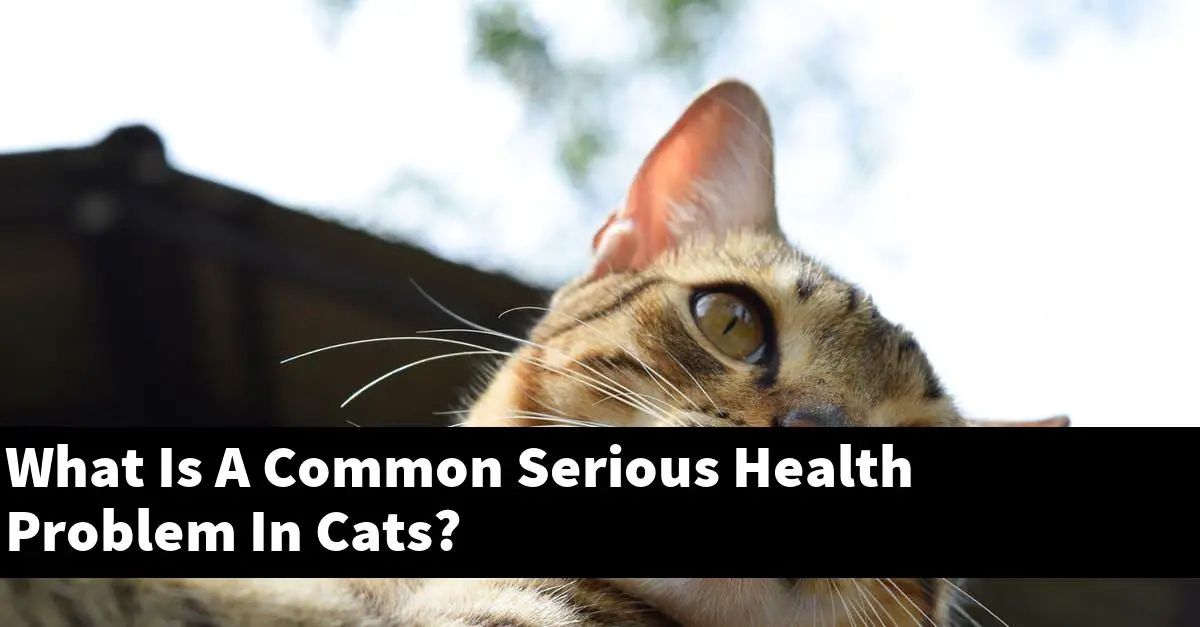Cats are susceptible to a number of health problems, many of which are serious. One of the most common serious health problems in cats is feline leukemia virus (FeLV). FeLV is a virus that attacks the cat’s immune system, making the cat susceptible to other diseases.
FeLV is most commonly spread through contact with infected saliva, so it is important to keep cats away from other cats that may be infected.
What health problems can cats have?
A cat can have a number of health problems, including:
-Bladder and urinary tract problems, including urinary tract infections, urethral blockages, and crystals in the urine
-Blindness and eye problems, including retinal degeneration and cataracts
-Cardiovascular problems, including heart disease, angina, and stroke
-Cancer
-Infertility
-Skin problems, including fleas, ticks, and ear mites
-And many more!
What is a life threatening condition for cats?
A life threatening condition for cats is feline leukemia.
What are the two most common medical conditions in cats that can be affected by diet?
The two most common medical conditions in cats that can be affected by diet are obesity and insulin resistance. Obesity is a health condition in which a cat has excess body fat, which can lead to health problems such as diabetes, heart disease, and cancer.
Insulin resistance is a condition in which the body’s cells don’t respond properly to the hormone insulin, which can lead to diabetes and other health problems. Feeding a cat a healthy diet that includes foods that are low in fat and high in fiber can help to prevent these conditions from developing.
What is the most common cause of death in cats?
The most common cause of death in cats is cancer. Other causes of death in cats include: accidents, infections, heart disease, stroke, and obesity.
What are the signs of a sick cat?
There are a few things that can indicate that a cat is sick, but the most common are changes in behavior or appetite. A cat that is not eating or drinking may have a fever, and may have trouble moving or staying awake.
A cat that is vomiting or having diarrhea may have a low white blood cell count or be in pain. A cat that is acting lethargic or having a decreased appetite may also be in pain.
What are the signs of cat dying?
There are a few signs to look for if you think your cat is dying. Your cat may become unresponsive or have difficulty breathing.
If your cat is not eating or drinking, this could be a sign of dehydration or starvation. If your cat has any wounds that are not healing, this could also be a sign of serious illness or death.
What is classed as an emergency for a cat?
A cat’s emergency is usually when they are injured or lost.
What is the typical lifespan for a cat?
The average lifespan for a cat is around 10-12 years. However, this can vary depending on the cat’s health and activity level.
Some cats may live up to 15 or even 20 years.
How do you know if your cat is crying for help?
There are several ways to determine if a cat is crying for help. One way is to listen for a specific cry that is specific to distress, such as when a cat is being chased or when it is being hurt.
Other ways to determine if a cat is crying for help include observing its body language and behavior, and reviewing its medical history.
Why do cats vomit yellow liquid?
There are a few potential causes of cats vomiting yellow liquid. One potential cause is a viral infection of the stomach, called gastritis.
This can be caused by a variety of viruses, including the common cold and the feline coronavirus. Gastritis can lead to nausea, vomiting, and diarrhea, and can be fatal in cats.
Another potential cause of cats vomiting yellow liquid is a problem with the liver. This can be caused by a variety of diseases, including hepatitis, liver cancer, and jaundice.
Vomiting can be an early sign of these diseases, and can lead to serious health problems if not treated.
Vomiting can also be a sign of another health problem, called catnip toxicity. This is a problem caused by excessive ingestion of catnip, which can lead to problems with the nervous system.
Cats that vomit often after eating catnip may be suffering from catnip toxicity, and should be seen by a veterinarian.
Conclusion
One common serious health problem in cats is called feline lower urinary tract disease (FLUTD). FLUTD is a condition that can cause a cat’s bladder and urethra to become inflamed. This can lead to difficulty urinating, bloody urine, and even complete blockage of the urethra.
If not treated promptly, FLUTD can be fatal.


